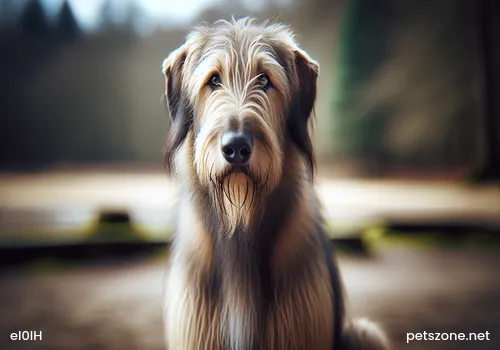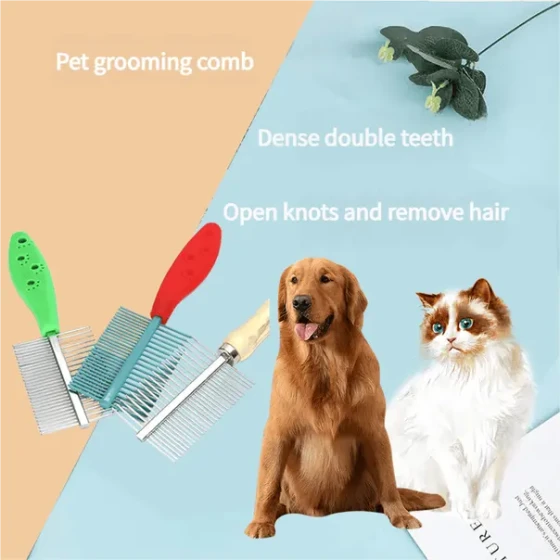Morphological Characteristics of the Otterhound

The ideal Otterhound male stands about 27 inches at shoulder height, weighing approximately 115 pounds. The female stands about 24 inches at shoulder height, weighing about 80 pounds. The Otterhound’s body is slightly rectangular, with the distance from the junction of the shoulder blade and upper arm to the rump slightly greater than the shoulder height. The Otterhound has excellent physique, strong leg bones, well-developed muscles, but not appearing coarse. A balanced, accurate, and typical structure is more important than size.
Morphological Characteristics
Head
Head: Huge, quite narrow, covered with abundant hair. A dog with a shoulder height of 26 inches has a head length from the tip of the nose to the occiput of about 11~12 inches, with the muzzle length roughly equal to the skull length. Proportions remain basically unchanged regardless of size.
Expression: Open and gentle.
Eyes
Deep set, the nictitating membrane is slightly visible. Eye color is dark, with ample pigmentation in the eyes and eye rims, consistent with the overall color. Dogs with black eye rims and nose leather have dark black eyes, while those with liver or blue-gray eye rims and nose leather have hazel eyes.
Ears
One of the important features of this breed, long, pendulous, and folded (the main edges folded or rolled like curtains). Ear position is low, even below the eyes, close to the head, and when stretched forward can reach the tip of the nose. Ears are covered with abundant hair.
Skull
(Skull): Long, quite narrow, covered with abundant hair, very slight arching. Stop: Not prominent. Muzzle: Square, not appearing elongated, powerful jaws, deep upper lips. From the side, the contour of the muzzle is parallel to the contour of the skull.
Nose leather: Large, dark color, ample pigmentation. Nostrils are wide.
Jaws: Powerful, the bite resembles strong pliers.
Bite: Scissor bite is preferred. [Neck, topline, body]
Neck: Strong, smoothly blending into the neatly sloped shoulders with sufficient length for good tracking of scent. Rich hair on the neck, allowing slight dewlap.
Topline: Straight from withers to the base of the tail.
Chest
A mature Otterhound's chest reaches the elbows in depth. The forechest is conspicuous, wide enough to provide strength and endurance. Should not appear narrow or weak.
Ribs: Well-sprung, oval-shaped, extending adequately towards the rear of the body.
Loin: Short, broad, and solid.
Tail
Set high, length sufficient to reach the hock. The root of the tail is thick, tapering towards the end, decorated with feathering (hair covering and bordering). When moving and alert, it is carried sabre-shaped above the back (not exceeding the back), but at rest, the Otterhound’s tail may hang down. Otterhound [Forequarters] scapula: Neat, strong, moderately sloping, with a proper angle between scapula and elbow.
Legs: Strong and straight bone, pastern sturdy and slightly elastic. Dewclaws on forelegs can be removed.
Paws
Both front and rear paws are large, wide, and compact when standing, but capable of spreading. Pads are thick and deep, toes arched; the paws are webbed (webbing between toes allowing spreading). [Hindquarters]
Thigh and second thigh: Huge, wide, and muscular.
Leg: The stifle joint moderately angled, hock clear.
Hocks
Set low, neither turned inward nor outward. When viewed from behind while standing, the hind legs are parallel. The angles of fore and hind limbs are coordinated with enough angulation to provide good forequarter reach and hindquarter drive. Dewclaws: If present on hind legs, usually removed.
Paws: As described above.
Coat
The coat is also a fundamental feature of the Otterhound. The texture and quality matter more than length. The outer coat is thick, coarse, rough, irregularly wavy. The hair on the head and lower parts of the legs is soft, naturally. The outer coat on the back is about 2~4 inches long, slightly shorter on the limbs. The waterproof undercoat is short, woolly, and slightly oily (a basic characteristic), but in summer, except on the thighs and shoulders, undercoat may become harder in other parts. Ears are covered with hair, and the tail has feathering (hair covering and bordering). Hair naturally sheds, lacking length and “fringe,” which is normal for a working Otterhound. The correct hunting dog coat should have a hard outer coat and woolly undercoat. The Otterhound should have a natural coat, not trimmed or sculpted.
Faults
Soft outer coat with woolly outer coat is a very serious fault. Lack of undercoat is also a serious fault. Coat longer than 6 inches, becoming heavy and damp, is a fault. Noticeable trimming, sculpting, or grooming of the coat will be severely penalized as faults.
Color
Any color or color combinations are acceptable. All colors are equally regarded. Nose leather color is dark and well pigmented, black, liver, or blue-gray, varying with coat color. Eye rim pigment matches nose leather.
Gait
The Otterhound's movement is free, with good forequarter reach and hindquarter drive. The stride is smooth, relaxed, capable of sustaining long distances. The typical Otterhound gait is a very relaxed, shuffling walk, suddenly springing into a relaxed, long-strided, healthy and lively trot with the head naturally extended forward. At a gallop, movement is smooth with a very long stride. At slow speeds, Otterhounds single track. When walking or moving slowly, the paws remain close to the ground, dragging along the step. The Otterhound’s lead should appear relaxed.
Temperament
The Otterhound is a kind, boisterous dog with a calm disposition.
-560x560.webp)

-560x560.webp)
